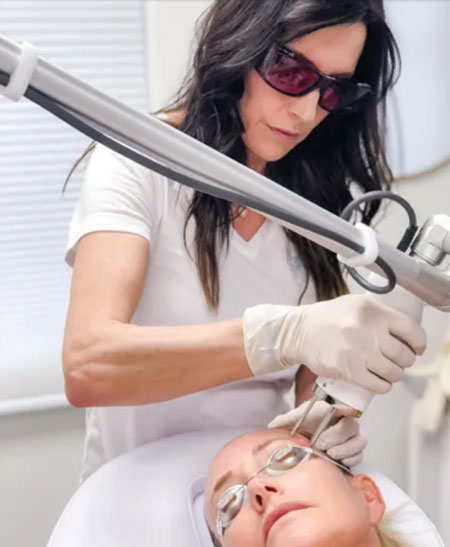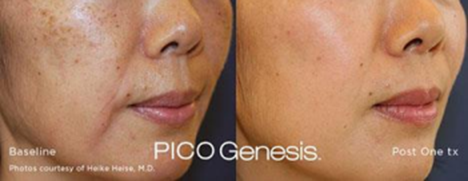Melasma Treatment
Melasma is a common skin condition characterized by the presence of brown or blue-grayish patches or freckle-like spots involving the skin. It typically occurs on the face and is symmetrical, involving both sides of the face. Brownish colored patches usually appear on the: cheek, forehead, bridge of the nose, and chin. It can also occur on the neck and forearms. Although the skin discoloration is benign, most patients feel self-conscious about the appearance of their skin. Melasma is caused by overproduction of Melanocytes which are responsible for the production of melanin which is responsible for the color in your skin. Although we are not completely certain what causes melasma, there seems to be a correlation between female sex hormones and sun exposure. Estrogen and progesterone sensitivity are also associated with this condition. Darker-skinned individuals are more prone than those with fairer skin. Birth control pills, sun exposure, pregnancy, and hormone therapy can all trigger melasma.
Medical treatment includes
Hydroquinone
This prescription topical cream is often a common first treatment for melasma. It is applied to the skin and works to even out your skin tone.
Tretinoin and corticosteroids
To enhance skin lightening, retinoid and corticosteroid creams may be prescribed.
Other topical creams such as azelaic acid or kojic acid can be prescribed to help reduce melasma.
Skin Treatments
If topical treatments are unsuccessful in managing your melasma, a variety of skin treatments can be performed which may improve the condition. Skin treatments for melasma include chemical peels, microdermabrasion, micro-needling, pico laser and fractional laser skin treatments.
Treatment of Melasma
Unfortunately, there is no quick fix solution for treating Melasma. Successful treatment involves using a combination of topical skin treatments with laser, chemical peels, and or micro-needling skin treatments. Using the proper skincare regimen is the slow and safest way to treat melasma. A period of 8 to 12 weeks is required to see results from topical therapy, since it takes this long for skin to entirely replenish itself. Results will be long-lasting and help prevent the recurrence of hyperpigmentation. The best skincare regimen in treating melasma targets all seven of the pathways that play a role in skin pigmentation:
1. Block pigment production.
2. Block the transfer of pigment from the PAR-2 pathway.
3. Prevent inflammation with anti-inflammatory ingredients.
4. Exfoliate the skin to generate new, even-toned skin.
5. Use antioxidants to prevent free radicals.
6. Use sunscreens to prevent activation of melanocytes.
7. Use moisturizers with unsaturated fatty acids, because some moisturizers block the effects of skin lightening ingredients.

A combination of creams can be used containing hydroquinone along with Vitamin A creams (e.g., retinoids and or Meladerm). Topical steroids, azelaic acid, kojic acid, glycolic acid, arbutin, and niacinamide serums are also used to treat this condition. Oral tranexamic acid is a novel treatment for melasma that has a multimodal mechanism of action. Also, oral glutathione supplementation may have a beneficial role in treating this condition.
Lasers alone will not remove melasma. The target of treatment is the melanocyte which produces melanin which is responsible for the pigment found in skin. While it may seem easy to target it with laser, melasma is much more complex and challenging to treat. Other cells and skin structures are involved in the skin making excess melanin and these also need to be targeted through treatments. Other topical therapies and even oral treatments might be required to assist with the treatment of melasma.
IPL (or Intense pulsed light) and BB (broad band) light should be avoided as these types of lasers can worsen and aggravate melasma and make it next to impossible to treat and control and so should be avoided in patients with melasma. Pico lasers, in contrast, are the safest laser used to treat melasma. At Regenesis, we use powerful Pico Laser technology to treat melasma. Our Pico laser uses short bursts of acoustical energy to treat unwanted pigment without damaging surrounding healthy tissue. Short bursts of laser energy penetrate deep into the skin and break up melanin, or pigment. After the melanin is damaged, your body will begin to absorb the damaged pigment and eliminate it naturally. Multiple laser treatments will be required. Unlike other laser skin treatments, the pico laser is non-thermal which is important as heat tends to exacerbate and worsen this skin condition.
Pico laser treatments leave the skin firm with little redness and swelling. Over time, the body removes and clears the damaged pigment, leaving your skin clearer. Unfortunately, there is no cure for Melasma. The skin of those affected is extremely sensitive to UV light and even the smallest amount can stimulate pigment cells to produce color. The mainstay of preventative therapy is strict UV sun protection, utilizing hats, sunglasses, and applying SPF every four hours while in the sun.
faqs
A series of three to four pico laser treatments are recommended to achieve optimal results. Maintenance treatments are encouraged to sustain results over time. Maximal results are seen at six weeks post treatment.
results

*Individual results may vary with different patient experiences.
*A series of treatments may be required for desired results.
